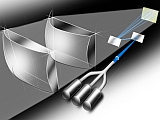"HipE" research project successfully completed
Step toward a fully adaptive lighting system based on laser technology
Lippstadt, July 9, 2019. HELLA GmbH & Co. KGaA, a globally leading automotive supplier for lighting and electronics, and the Fraunhofer Application Center for Inorganic Phosphors in Soest, are co-developing a prototype lighting system for the future based on laser technology. The HipE (highly innovative pixelated phosphors for laser-based emissions in headlamps) research project was funded by the European Regional Development Fund (ERDF) over a period of three years and was successfully completed in February 2019.
To project the light exactly where the driver needs it when driving on public roads as well as detect potential hazards earlier on so that they can be avoided as quickly as possible, a fully adaptive, high-resolution light distribution system is required that can adapt to the traffic situation at hand in real time. To this end, both the headlamp and corresponding sensor system must be fitted to the vehicle. At the same time, the system must meet the heightened requirements when it comes to packaging, efficiency and illumination quality.
It is in this context that the Fraunhofer Application Center for Inorganic Phosphors tested different materials with respect to their suitability as part of the HipE research project - i.e. with regard to their conversion characteristics and heat propagation. The materials were then structured using a femtosecond laser, the removal parameters were optimized, the contrast was increased and the heat propagation in the pixelated phosphor was analyzed. During the course of the research project, HELLA designed and built a prototype for a high-resolution headlamp module incorporating a laser light source for subsequent use in the headlamp assembly. The lighting and electronics expert also checked which optical systems are suitable for meeting the requirements for a more compact design and greater efficiency.
As a result, it can be stated that structuring the phosphors can significantly improve the contrast between two pixels. To fully meet the requirements of a headlamp application, however, additional measures must be subsequently implemented to improve the contrast still further. The two project partners will continue to work together on this after the end of the research project.
Daniel Morfeld
Spokesperson / Media Relations
Rixbecker Str. 75
59552 Lippstadt
Phone: +49 2941 38-7566
Fax: +49 2941 38-477545
Daniel.Morfeld@forvia.com






